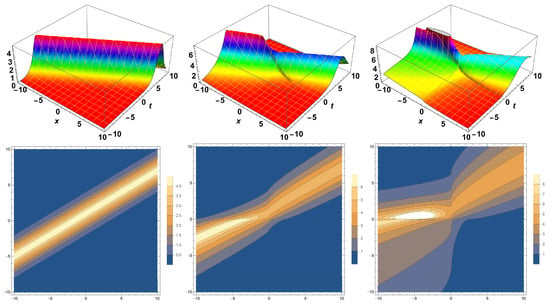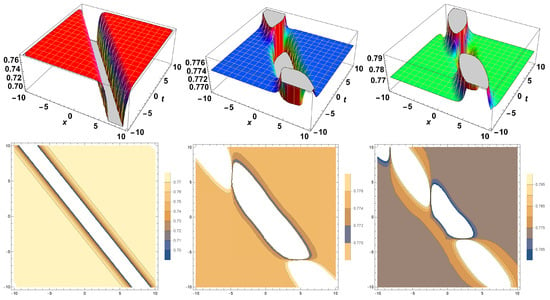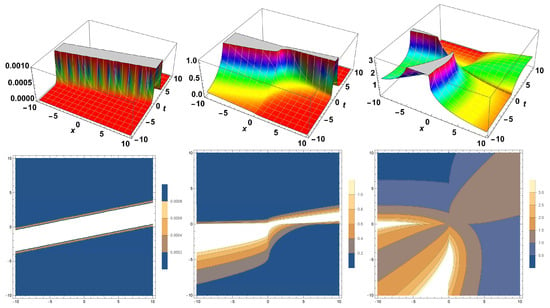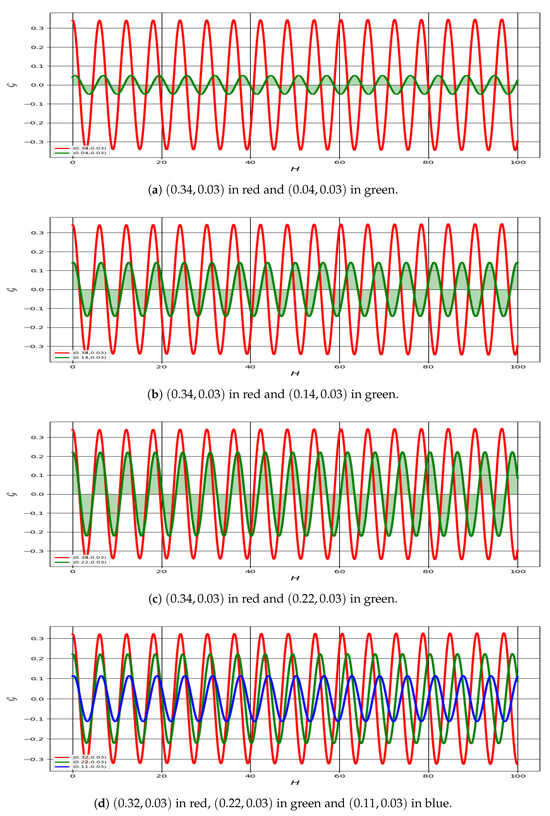Abstract
The present paper examines a novel exact solution to nonlinear fractional partial differential equations (FDEs) through the Sardar sub-equation method (SSEM) coupled with Jumarie’s Modified Riemann–Liouville derivative (JMRLD). We take the (3+1)-dimensional space–time fractional modified Korteweg-de Vries (KdV) -Zakharov-Kuznetsov (ZK) equation as a case study, which describes some intricate phenomena of wave behavior in plasma physics and fluid dynamics. With the implementation of SSEM, we yield new solitary wave solutions and explicitly examine the role of the fractional-order parameter in the dynamics of the solutions. In addition, the sensitivity analysis of the results is conducted in the Galilean transformation in order to ensure that the obtained results are valid and have physical significance. Besides expanding the toolbox of analytical methods to address high-dimensional nonlinear FDEs, the proposed method helps to better understand how fractional-order dynamics affect the nonlinear wave phenomenon. The results are compared to known methods and a discussion about their possible applications and limitations is given. The results show the effectiveness and flexibility of SSEM along with JMRLD in forming new categories of exact solutions to nonlinear fractional models.
1. Introduction
Partial differential equations play both an effective and active role in modeling natural phenomena and complex phenomena in theoretical and applied physics. Partial differential equations (PDEs) that deal simultaneously with multiple functions and their partial derivatives with respect to different variables are basic tools for modeling most physical phenomena, such as fluid dynamics, heat transfer, and structural mechanics [,,,,]. Depending on the properties of their solutions and the type of governing equations, PDEs are usually divided into three types: elliptic, parabolic, and hyperbolic. A classical example of a phenomenon described by an elliptic PDE is the temperature distribution of a steady-state object. Parabolic PDEs including the heat equation are termed as time-dependent phenomena with the effort of heat in a solid body. Hyperbolic partial differential equations similar to the wave equation describe the propagation of waves including electromagnetic and sound waves. Numerical methods are often employed to approximate solutions to PDEs because of their well-known difficulty in solving them. Solving PDEs and understanding characteristics such as their existence, uniqueness, and regularity are important aspects of the subject. PDEs are important tools in engineering for simulating, modeling, and optimizing complex schemes []. They are applied to problems in image processing, electro magnetics, fluid dynamics, heat transport, structural mechanics, and optimization.
Fractional differential equations (FDEs) are differential equations that have derivatives of any order. Examples of natural phenomena modeled by partial differential equations appear in chemical physics, viscoelasticity, control theory, fluid flow, rheology, diffusive transport, electrical networks, probability and statistics, and dynamical processes in self-similar and porous structures. Fractional derivatives decrease into two main categories: Riemann–Liouville and caputo fractional derivatives (CFD), depending on the derivative’s formulation and order. The Riemann–Liouville integral is a generalization of the integral operator for integer-order derivatives, which is used to form Riemann–Liouville fractional derivatives (RLFD). The Caputo derivative, defined by the fractional integral, is a generalization of the classical integer-order derivative and is commonly used in modeling fractional differential equations because of its ability to incorporate conventional initial conditions in physical systems. The decision between the two forms of fractional derivative depends on the specific problem being solved. Each has advantages and applications of its own. Because fractional differential equations have so many applications across varied domains, they have been carefully investigated. For example, the Wang and Zhang [] studied a family of Hadamard fractional derivatives containing nonlinear fractional-order differential impulsive systems []. Naz et al. [] explored the modified exponential approach using a fractional-order longitudinal wave equation. Muhammad et al. [] investigated the fractional Tzitzeica equation for modeling complex phenomena by using the -expansion technique. Systems of FDEs have been solved using the differential transform method, which yields approximate analytical solutions in the form of convergent series with readily computed components.
The progress of weakly dispersive and weakly nonlinear wave packets in definite physical schemes is described by the modified Korteweg–de Vries (KdV)–Zakharov–Kuznetsov equation, which is a nonlinear PDE. It is an extension of the traditional KdV equation that adds higher-order nonlinearity and distribution, between other effects. Applications for the modified KdV–Zakharov–Kuznetsov equation can found in fluid dynamics, plasma physics, and nonlinear optics, among other areas. Research indicates its potential to estimate and deal with wave dynamics in real-world applications, as well as its ability to provide insights into the behavior of wave phenomena in complex systems.
The (3+1)-dimensional space-time fractional modified Kdv–Zakharov–Kuznetsov equation [] is written as follows:
where and are arbitrary constants with . The problem lies in multiple space dimensions. The MKdV–ZK equation appears as weakly 2-dimensional variations of the Mkdv equation []. In plasma, Mkdv is a model that can be derived for the development of ion-acoustic perturbation along two negative ion components of various temperatures.
In order to find exact solutions for the fractional MKdV–ZK equation, specific effective methods have been advanced. The extended direct algebraic method [], Series solution [], Generalized Arnous method [], and Lie symmetry analysis [] are some of these methods. These methods provide opportunities to consider the equation’s analysis and solution, contributing insightful information about its behavior and possible application in various scientific and technical domains.
This paper suggests using JMRLD [] together with SSEM to obtain exact solutions for nonlinear FDEs. This study’s main goal to cover the capabilities of this method by using them to produce exact solutions for FDEs in space and time that relate to JMRLD. One of the important limitations of the classical Riemann–Liouville derivative, resolved by Jumarie modification of the Riemann–Liouville fractional derivative, is the guarantee that the fractional derivative of any constant is zero and that it leads to a more coherent extension of classical calculus to fractional orders. In addition, this formulation maintains some fundamental functional relationships, like the Mittag–Leffler function being analogous to the exponential one when differentiated, enabling analytical solutions to fractional differential equations. The aim of this paper is to expand the field of mathematical modeling and analysis by improving our command and application of exact solution techniques for FDEs. The JMRLD of order is defined by the following expression [] is
where describes a function that is continuous and satisfies the following properties.
Property 1.
Let us now consider the case , which refers to the function that is continuous on . The following equality holds for integral []:
Property 2.
Property 3.
Property 4.
where a and b are constants.
Property 5.
, where c is a constant.
Sensitivity analysis is an essential tool for understanding the behavior and reliability of complex models [,,,]. It identifies the parameters to check that have an influence on outcomes, allowing researchers and decision-makers to focus their attention where it matters [,,]. By assessing how small changes in inputs affect results, it evaluates the robustness and stability of a system, highlighting potential weaknesses or areas of uncertainty [,]. In this way, sensitivity analysis not only guides the improvement and validation of models, but also supports more confident and informed decision-making across fields such as engineering, finance, environmental studies, and scientific research [,,,,].
The layout of the paper is as follows: Section 2 discusses the Methodology, Section 3 covers the Execution of the Methodology, Section 4 presents the Simulation and Discussion, Section 5 provides the Sensitivity Analysis of the Model, Section 6 concludes the study, and, finally, Section 7 outlines the future scope of the study.
2. Methodology
In this section, the Sardar sub-equation technique has been explained, which can be applied to various differential equations including FDEs to derive analytic solutions. An efficient analytical method that is frequently employed to solve nonlinear partial differential equations (PDEs) that arise in mathematical physics and applied sciences is the Sardar sub-equation method (SSM). Bright, dark, singular, periodic, and combined soliton solutions are among the many types of exact solutions that SSM can systematically produce. These solutions are important for the understanding of complex nonlinear waves phenomena in various physical environments such as fluid dynamics, quantum mechanics, and plasma physics and optics [,,,,]. Let us briefly explain this methodology.
- Step 1: Consider NLPDE as follows:
- Step 2: Utilize the following traveling wave transformation:
- Step 4: The solution of (3) is as follows:
- Step 5: The solutions of (5) are given as follows:
- Case I: If and , we have:
- Case II: If and , we have:
- Case III: If and , afterward:
,
- Case IV: If and , afterward:
,
3. Execution of Methodology
In this section, we apply the Sardar sub-equation to find the analytic solution of the (3+1)-dimensional fractional Mkdv–ZK equation. Fractional differential equations have regained breadth because they capture memory and hereditary aspects of many different processes in science and engineering, and have become essential in modeling these phenomena. Here, we note the fascinating (3+1)-dimensional fractional modified KdV–ZK equation, which has both many interesting physical implications and whose analytic features are perplexing. The following traveling wave transformation is used to convert PDE into ODE:
where , and q are non-zero constants. Substitute the values of (8) with all required derivatives into (1) to reduce into following ordinary differential equation (ODE).
By integrating the above equation w.r.t , we have
where C is the integrating constant. Balance the highest derivative and nonlinear term such as , and yields . Thus, (5) is reduced into the following:
where are constants. Substituting (10) into (9) and then comparing the polynomial coefficients of all powers of is equal to zero. We obtain
The analytic solutions of (1) are listed below.
- Case I: If , and , we have
- Case II: If and , we have
- Case III: If and , we have:
- Case IV: If and , we have
4. Simulation and Discussion
In this work, we provide a visualization of the solutions found in the form of a 3D surface and contours in order to see how the fractional parameter affects the behavior of the system as shown in Figure 1, Figure 2, Figure 3 and Figure 4. In particular, we study the fractional modified KdV–ZK equation in space–time with a hybrid of the techniques of Jumarie modified Riemann–Liouville derivative and the sub-equation method (SSEM). The method provides a variety of accurate solutions, which can be used to gain useful information about the influence of fractional-order effects on the properties of solutions. According to our graphical outcomes the evolution of solution profiles is very sensitive to changes in the fractional order. When this parameter is systematically varied, we see a wide array of behaviors—including small modulations of wave profiles to profound modification of soliton interactions. The discussion shows that the value of the fractional order significantly affects soliton interactions. When the fractional parameter is changed only slightly, soliton interactions are largely repulsive, so the solitons can preserve their unique identities. But, when the fractional order is larger than a particular value, the interaction will be attractive, resulting in the existence of bound states. Solitons combine in these states and transform into more complex solitary structures.

Figure 1.
3D and contour plots of with parameters .

Figure 2.
3D and contour plots of with parameters

Figure 3.
3D and contour plot of with parameters

Figure 4.
3D and contour plot of with parameters
Results Comparison
Table 1 contrasts this study with previous research, emphasizing its unique contributions.

Table 1.
Comparison of the current study with Guner et al. [].
5. Sensitivity Analysis
In this section, we investigate the sensitivity of the fractional modified KdV–ZK equation to varying initial conditions. To this end, we apply the Galilean transformation to Equation (9), yielding the following dynamical system []:
To investigate the sensitivity of the model, we consider four different sets of initial conditions. Figure 5a displays two solution trajectories arising from the initial conditions and , represented by the red and green curves, respectively. Figure 5b illustrates two solution paths generated from the starting points and , shown by the red and green trajectories, respectively. In Figure 5c, two solution trajectories originating from and are presented as the red and green curves, respectively. Finally, Figure 5d showcases three solution trajectories arising from the initial conditions , , and , depicted by the red, green, and blue curves, respectively. As observed, even slight variations in the initial conditions result in noticeable differences in the dynamics of system (12). In other words, no two solution curves coincide [,], highlighting that the system is sensitive to its initial states, although this sensitivity is not exceedingly strong.

Figure 5.
Sensitivity of the system (12) of system.
6. Conclusions
The research on the optical soliton solutions for the (3+1)-dimensional space–time fractional Mkdv–ZK equation has generated substantial perceptions into the behavior of solitons in complex dimensions. Using SSEM, new analytical soliton solutions have been derived, showing varied possessions and dynamics in nonlinear wave phenomena. In addition, the combination of fractional calculus has exposed the effect of fractional order on these soliton solutions, and considered the complexity and exclusive physical appearance introduced by fractional derivatives. This study contributes to a better understanding of how fractional calculus affects soliton dynamics, offering useful insights for nonlinear science and optical communication applications. The combination of the Sardar sub-equation method (SSEM) and the study of fractional-order effects offers new options for future research into the complicated dynamics of optical solitons in complex physical systems. The system is extremely sensitive to changes in the starting conditions. The new solitary wave solutions and sensitivity analysis described here provide a better understanding of how fractional-order dynamics influence wave propagation, which is important for building and managing systems in domains like plasma confinement, nonlinear optics, and material sciences.
7. Future Scope of Study
The current paper shows how the Sardar sub-equation technique coupled with the modified fractional derivative approach due to Jumarie can be exploited to obtain exact solitary wave solutions of the (3+1)-dimensional fractional generalized KdV–ZK equation. Based on these findings, additional studies can be developed in a number of potentially interesting ways. To begin with, one can carry the method further to include numerical investigations and stability studies that will give further information on the stability and physical viability of the solutions found. Also, this method can be extended to other nonlinear fractional models in fluid dynamics, plasma physics, and nonlinear optics to further expand its applicability. The combination of quantitative sensitivity and bifurcation analysis would help better understand the solutions’ parameter-dependent behavior. Lastly, an interesting direction for developing the theoretical and practical features of fractional soliton dynamics is to extend the method to higher-dimensional systems and linked nonlinear equations. In future work, this can be extended to investigate its rich dynamics through exploring lump solutions, PINN-based approaches, and other advanced numerical methods. Such studies will deepen our understanding of its behavior and broaden its range of applications in nonlinear modeling and complex dynamical systems.
Author Contributions
Conceptualization, B.; Methodology, S.Y. and B.; Software, S.Y. and B.; Formal analysis, A.K., F.S.A., S.Y. and B.; Investigation, A.K., F.S.A. and B.; Writing—original draft, B.; Writing—review & editing, A.K., F.S.A., S.Y. and B.; Visualization, B.; Supervision, F.S.A.; Project administration, F.S.A.; Funding acquisition, F.S.A. All authors have read and agreed to the published version of the manuscript.
Funding
This work was supported and funded by the Deanship of Scientific Research at Imam Mohammad Ibn Saud Islamic University (IMSIU) (grant number IMSIU-DDRSP2503).
Data Availability Statement
The article contains all the data related to this research.
Acknowledgments
The authors extend their appreciation to the Deanship of Scientific Research at Imam Mohammad Ibn Saud Islamic University (IMSIU) for supporting this publication.
Conflicts of Interest
The authors declare no conflicts of interest.
References
- Bao, W.; Liu, H.; Wang, F.; Du, J.; Wang, Y.; Li, H.; Ye, X. Keyhole critical failure criteria and variation rule under different thicknesses and multiple materials in K-TIG welding. J. Manuf. Processes 2024, 126, 48–59. [Google Scholar] [CrossRef]
- Yi, X.; Zhao, R.; Lin, Y. The impact of nighttime car body lighting on pedestrians’ distraction: A virtual reality simulation based on bottom-up attention mechanism. Saf. Sci. 2024, 180, 106633. [Google Scholar] [CrossRef]
- Zhang, Z.; Lin, M.; Li, D.; Wu, R.; Lin, R.; Yang, C. An AUV-enabled dockable platform for long-term dynamic and static monitoring of marine pastures. IEEE J. Ocean. Eng. 2025, 50, 276–293. [Google Scholar] [CrossRef]
- Zhao, L.; Weng, W.; Ni, M.; Shen, H.; Zhang, S.; Chen, Y.; Wang, Y. Rubidium salt can effectively relieve the symptoms of DSS-induced ulcerative colitis. Biomed. Pharmacother. 2024, 181, 117574. [Google Scholar] [CrossRef] [PubMed]
- Huang, G.; Liang, J.; Chen, X.; Lin, J.; Wei, J.; Huang, D.; Zhao, L. Isolation and identification of chemical constituents from Zhideke Granules by ultra-performance liquid chromatography coupled with mass spectrometry. J. Anal. Methods Chem. 2020, 2020, 8889607. [Google Scholar] [CrossRef] [PubMed]
- Sobolev, S.L. Partial Differential Equations of Mathematical Physics: Adiwes International Series in Mathematics; Elsevier: Amsterdam, The Netherlands, 2014. [Google Scholar]
- Harisa, S.A.; Ravichandran, C.; Nisar, K.S.; Faried, N.; Morsy, A. New exploration of operators of fractional neutral integro-differential equations in Banach spaces through the application of the topological degree concept. AIMS Math 2022, 7, 15741–15758. [Google Scholar] [CrossRef]
- Murugesan, M.; Muthaiah, S.; Vadivel, R.; Unyong, B. Existence of Solutions for Coupled System of Sequential Liouville–Caputo-Type Fractional Integrodifferential Equations. Fractal Fract. 2023, 7, 800. [Google Scholar] [CrossRef]
- Naz, S.; Rani, A.; Ul Hassan, Q.M.; Ahmad, J.; Rehman, S.U.; Shakeel, M. Dynamic study of new soliton solutions of time-fractional longitudinal wave equation using an analytical approach. Int. J. Mod. Phys. B 2024, 38, 2450420. [Google Scholar] [CrossRef]
- Mohammed, W.W.; Khatun, M.M.; Algolam, M.S.; Sidaoui, R.; Akbar, M.A. Analytical Solitary Wave Solutions of Fractional Tzitzéica Equation Using Expansion Approach: Theoretical Insights and Applications. Fractal Fract. 2025, 9, 438. [Google Scholar] [CrossRef]
- Guner, O.; Aksoy, E.; Bekir, A.; Cevikel, A.C. Different methods for (3+1)-dimensional space–time fractional modified KdV–Zakharov–Kuznetsov equation. Comput. Math. Appl. 2016, 71, 1259–1269. [Google Scholar] [CrossRef]
- Demontis, F. Exact solutions of the modified Korteweg-de Vries equation. Theor. Math. Phys. 2011, 168, 886–897. [Google Scholar] [CrossRef]
- Ansari, A.R.; Jhangeer, A.; Imran, M.; Beenish; Inc, M. A study of self-adjointness, Lie analysis, wave structures, and conservation laws of the completely generalized shallow water equation. Eur. Phys. J. Plus 2024, 139, 489. [Google Scholar] [CrossRef]
- Jhangeer, A.; Ansari, A.R.; Imran, M.; Riaz, M.B. Conserved quantities and sensitivity analysis influence of damping effect in ferrites materials. Alex. Eng. J. 2024, 86, 298–310. [Google Scholar] [CrossRef]
- Samreen, M. Analytical solutions and dynamical insights of the modified Benjamin–Bona–Mahony equation with applications in nonlinear optics. J. Appl. Math. Comput. 2025. [Google Scholar] [CrossRef]
- Beenish; Samreen, M.; Alshammari, F.S. Exploring Solitary Wave Solutions of the Generalized Integrable Kadomtsev–Petviashvili Equation via Lie Symmetry and Hirota’s Bilinear Method. Symmetry 2025, 17, 710. [Google Scholar] [CrossRef]
- Jumarie, G. Modified Riemann-Liouville derivative and fractional Taylor series of nondifferentiable functions further results. Comput. Math. Appl. 2006, 51, 1367–1376. [Google Scholar] [CrossRef]
- Jumarie, G. Table of some basic fractional calculus formulae derived from a modified Riemann–Liouville derivative for non-differentiable functions. Appl. Math. Lett. 2009, 22, 378–385. [Google Scholar] [CrossRef]
- Liu, W.; Chen, K. The functional variable method for finding exact solutions of some nonlinear time-fractional differential equations. Pramana 2013, 81, 377–384. [Google Scholar] [CrossRef]
- Abbasbandy, S.; Shirzadi, A. The first integral method for modified Benjamin–Bona–Mahony equation. Commun. Nonlinear Sci. Numer. Simul. 2010, 15, 1759–1764. [Google Scholar] [CrossRef]
- Bekir, A.; Guner, O.; Cevikel, A. The exp-function method for some time-fractional differential equations. IEEE/CAA J. Autom. Sin. 2016, 4, 315–321. [Google Scholar] [CrossRef]
- Ibragimov, N.H.; Ibragimov, R.N. Applications of Lie group analysis to mathematical modelling in natural sciences. Math. Model. Nat. Phenom. 2012, 7, 52–65. [Google Scholar] [CrossRef][Green Version]
- Yomba, E. The extended Fan’s sub-equation method and its application to KdV–MKdV, BKK and variant Boussinesq equations. Phys. Lett. A 2005, 336, 463–476. [Google Scholar] [CrossRef]
- Odabasi, M.; Misirli, E. On the solutions of the nonlinear fractional differential equations via the modified trial equation method. Math. Methods Appl. Sci. 2018, 41, 904–911. [Google Scholar] [CrossRef]
- Kudryashov, N.A. Simplest equation method to look for exact solutions of nonlinear differential equations. Chaos Solitons Fractals 2005, 24, 1217–1231. [Google Scholar] [CrossRef]
- Akram, S.; ur Rahman, M.; AL-Essa, L.A. A comprehensive dynamical analysis of (2+1)-dimensional nonlinear electrical transmission line model with Atangana–Baleanu derivative. Phys. Lett. A 2025, 555, 130762. [Google Scholar] [CrossRef]
- San, S.; Beenish; Alshammari, F.S. Analytical and Dynamical Study of Solitary Waves in a Fractional Magneto-Electro-Elastic System. Fractal Fract. 2025, 9, 309. [Google Scholar] [CrossRef]
- Yang, Z.Q.; Hou, K.P.; Guo, T.T. Research on time-varying behavior of cement grouts of different water-cement ratios. Appl. Mech. Mater. 2011, 71, 4398–4401. [Google Scholar] [CrossRef]
- Yang, Z.Q.; Hou, K.P.; Cheng, Y.; Yang, B. Study of column-hemispherical penetration grouting mechanism based on power-law fluid. Chin. J. Rock Mech. Eng. 2014, 33, 3840–3846. [Google Scholar]
- Yang, Z.Q.; Zhu, Y.Y.; Zou, D.S. Formation conditions and risk evaluation of glacial debris flow disasters along International Karakorum Highway (KKH). Ital. J. Eng. Geol. Environ. 2011, 1031–1037. [Google Scholar] [CrossRef]
- Yang, Z.; Xiong, J.; Zhao, X.; Meng, X.; Wang, S.; Li, R.; Xu, H. Column-hemispherical penetration grouting mechanism for Newtonian fluid considering the tortuosity of porous media. Processes 2023, 11, 1737. [Google Scholar] [CrossRef]
- Gao, J. Friction coefficient estimation of the clutch in automatic transmission based on improved persistent excitation condition. In Proceedings of the 2017 Chinese Automation Congress (CAC), Jinan, China, 20–22 October 2017; IEEE: Piscataway, NJ, USA, 2018; p. 5647. [Google Scholar]
- Wu, Z.; Wang, J.; Zhang, X.; Cao, M.; Wu, A. Preliminary studies on diagnostic cast of peptic ulcer based on saliva proteome and bioinformatics. In Proceedings of the 2011 4th International Conference on Biomedical Engineering and Informatics (BMEI), Shanghai, China, 15–17 October 2011; IEEE: Piscataway, NJ, USA, 2011; Volume 3, pp. 1597–1600. [Google Scholar]
- Wu, Z.Z.; Wang, J.G.; Zhang, X.L.; Cao, M.Q. Preliminary study on saliva proteomics of different furs in digestive system diseases. In Proceedings of the 2009 IEEE International Symposium on IT in Medicine & Education, Jinan, China, 14–16 August 2009; IEEE: Piscataway, NJ, USA, 2009; Volume 1, pp. 56–61. [Google Scholar]
- Xiang, D.; He, D.; Sun, H.; Gao, P.; Zhang, J.; Ling, J. HCMPE-Net: An unsupervised network for underwater image restoration with multi-parameter estimation based on homology constraint. Opt. Laser Technol. 2025, 186, 112616. [Google Scholar] [CrossRef]
- Guan, Y.; Cui, Z.; Zhou, W. Reconstruction in off-axis digital holography based on hybrid clustering and the fractional Fourier transform. Opt. Laser Technol. 2025, 186, 112622. [Google Scholar] [CrossRef]
- Ni, Z.L.; Ma, J.S.; Liu, Y.; Li, B.H.; Nazarov, A.A.; Li, H.; Wang, X.X. Numerical analysis of ultrasonic spot welding of Cu/Cu joints. J. Mater. Eng. Perform. 2025. [Google Scholar] [CrossRef]
- Fang, Q.; Sun, Q.; Ge, J.; Wang, H.; Qi, J. Multidimensional Engineering of Nanoconfined Catalysis: Frontiers in Carbon-Based Energy Conversion and Utilization. Catalysts 2025, 15, 477. [Google Scholar] [CrossRef]
- Mace, R.L.; Hellberg, M.A. The Korteweg–de Vries–Zakharov–Kuznetsov equation for electron-acoustic waves. Phys. Plasmas 2001, 8, 2649–2656. [Google Scholar] [CrossRef]
- Kopçasız, B. Qualitative analysis and optical soliton solutions galore: Scrutinizing the (2+1)-dimensional complex modified Korteweg–de Vries system. Nonlinear Dyn. 2024, 112, 21321–21341. [Google Scholar] [CrossRef]
Disclaimer/Publisher’s Note: The statements, opinions and data contained in all publications are solely those of the individual author(s) and contributor(s) and not of MDPI and/or the editor(s). MDPI and/or the editor(s) disclaim responsibility for any injury to people or property resulting from any ideas, methods, instructions or products referred to in the content. |
© 2025 by the authors. Licensee MDPI, Basel, Switzerland. This article is an open access article distributed under the terms and conditions of the Creative Commons Attribution (CC BY) license (https://creativecommons.org/licenses/by/4.0/).